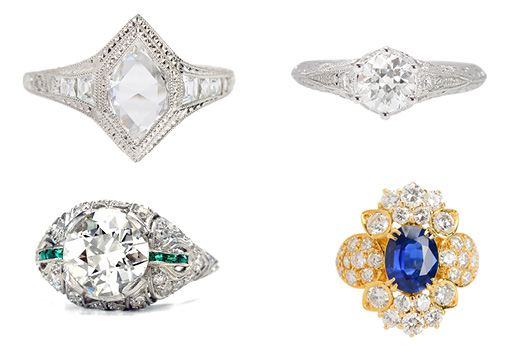
For many antique and estate jewelry dealers, the Original Miami Beach Antique Show is a must-attend event. A welcome respite from mid-winter weather, it allows dealers to sell to local and international buyers as well as among themselves, giving them a firsthand pulse-check of the market for the upcoming year.
For the second year, the show — which took place February 9 through 12 — was at an alternative venue, the Miami Fair Expo Center. Its usual home, the Miami Convention Center, is being renovated. But the alternate location of the annual show did not seem to dampen the experiences of the dealers who attended.
“It was a very strong show,” says Gus Davis, a partner in New York-based estate jeweler Camilla Dietz Bergeron. “The traffic was good, and there was a lot of interest.”
Jeff Cohen, owner of N. Green & Sons in Chicago, Illinois, rates the show as better than 2017’s. “We saw activity, and the aisles were full every day of the show,” he reports.
Lisa Stockhammer-Mial, president of online retailer The Three Graces, went to the show to buy rather than sell. She concentrated on gemstone-set and diamond rings, which she says she bought from dealers in both the US and the UK. She was on the lookout for Art Deco, Edwardian or vintage styles with those aesthetics, as well as unusual diamond cuts and shapes.
Janet Levy, principal at J. & S.S. DeYoung in New York, found that the buyers were “mostly high-end people from the States or overseas, especially Asia and Europe.”
Cohen says he noticed strong buying from Hong Kong and Singapore clients, who went for traditional pieces like Art Deco jewelry, brooches, rings and bracelets.
Gold sold
“What I liked about this show,” says Davis, “was that people were interested in pretty jewelry. I saw a lot of yellow-gold jewelry being sold. It still had to make a statement and had to be fine, but it didn’t have to be signed, and I thought that was very positive.”
Cohen agrees that gold jewelry, not necessarily signed pieces, was a surprisingly strong selling trend this year. “In women’s jewelry, it was rings, cocktail rings and chunkier bracelets, earrings. We were showing a lot of more modern pieces — 1950s, ’60s, ’70s, ’80s yellow gold.”
Diamonds still dazzle
Diamonds were hot, continues Cohen. “We were showing a lot of old-mine cuts, European cuts.” A nice surprise, he says, was that he sold a lot of diamond pins, single and double clips, and “bar pins with bigger, better, cleaner stones.”
Davis also feels there was strong interest in diamonds. “Diamond rings were very big sellers,” he says. “People liked Edwardian and Deco rings, but people were also interested just in the stones.”
Color a popular choice
The other strong sellers, notes Levy, were “fine colored stones that have minor or no treatments: unheated Burma rubies, Kashmir sapphires and beautiful Colombian emeralds.”
Cohen agrees that colored stones with no treatment were highly sought-after, especially sapphires. “But even jewelry with treated stones, if it was well-made and had strong style, found buyers,” he adds.
Good, signed pieces by Cartier, Van Cleef & Arpels and Harry Winston continue to be strong, reports Levy. “People are collecting them, people are buying them, people feel confident in the quality of the traditional houses,” she comments.
“Very stylish jewelry from makers like Mauboussin, Boivin, makers who have some design personality that translates into their jewelry, is [also] selling well,” she elaborates. “That market continues to be strong. I don’t see it wavering at all.”
Mid-market demand
Mid-range jewelry was a little less sought-after, according to Stockhammer-Mial. “More expensive, important or unusual jewels were in demand, and less expensive, small wearable jewelry was strong,” she says.
Davis, however, says there was an uptick in the mid-price range at the show — pieces priced between $2,000 and $5,000.
Levy notes a trend of wearing more gold and everyday jewelry, at least in America. “A beautiful but unsigned 1920s Art Deco diamond bracelet [is] a bargain now, selling for $15,000 or $20,000, because there are enough of them in the marketplace. I would say that category is a weak area in terms of prices,” she points out. “[But] the low end, under $1,000 to $3,000, is selling, especially to retailers who can buy a little gold pin with a small ruby or something charming without a big outlay.”
A positive indicator
“People still have a strong interest in antique and estate jewelry,” says Davis. “It’s nice that now the lower and mid-range jewelry is selling. That’s quite a positive.”
Cohen is hopeful about the coming year. “We had people contact us after the show for a few sales. And some jewelry friends across the country who didn’t attend the show have stated that since Christmas, they have had very active and good estate-jewelry business,” he says.
Levy points out that business and attendance were better this year, “so I think that’s a good sign as to the state of the market.”
Stockhammer-Mial, meanwhile, sums up the market as being overall “very optimistic, with an upward trend and a renewed interest in jewelry, diamonds and colored gemstones.”
Images: Camilla Dietz Bergeron; The Three Graces.Article from the Rapaport Magazine - March 2018. To subscribe click here.